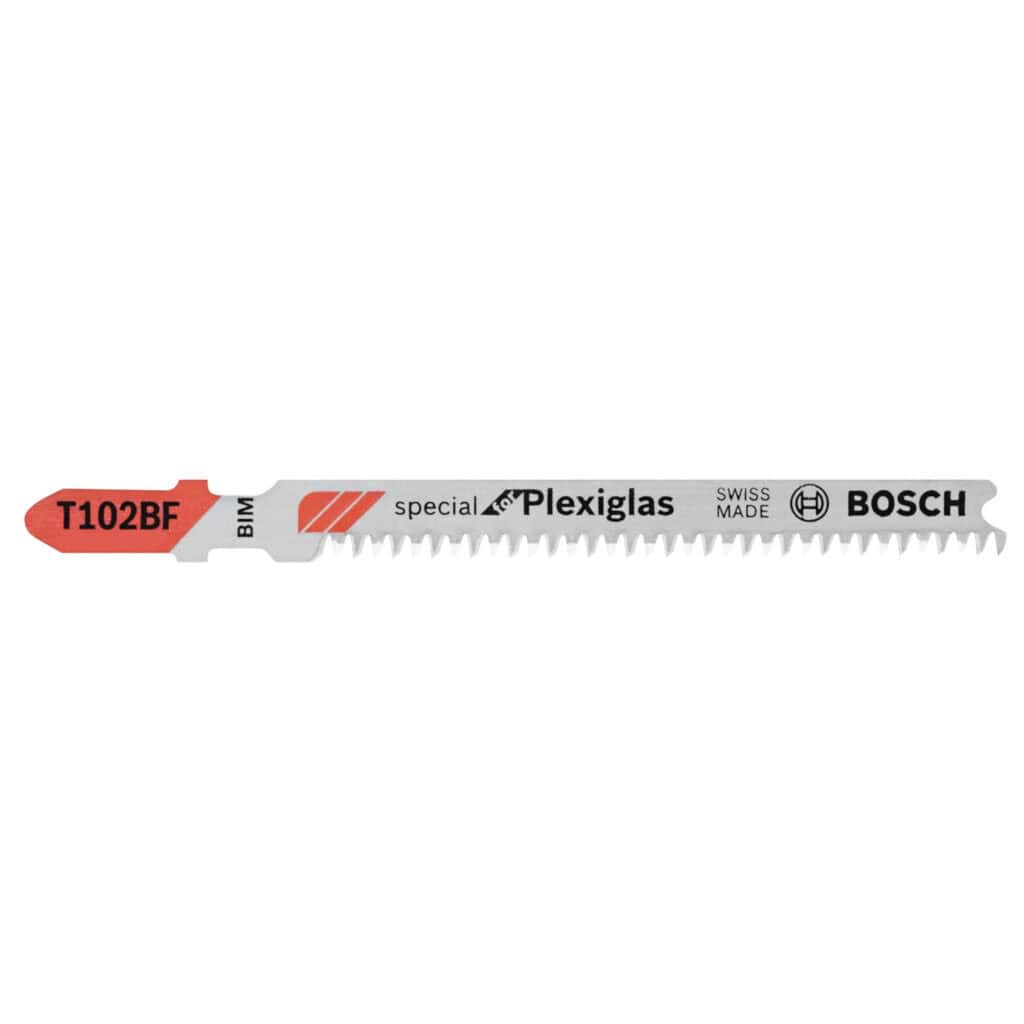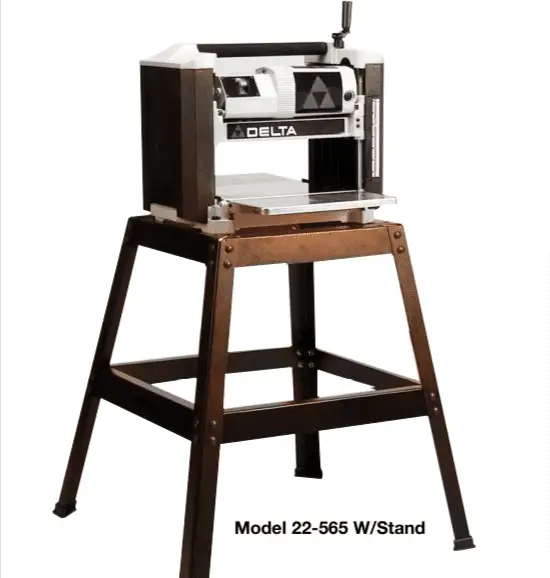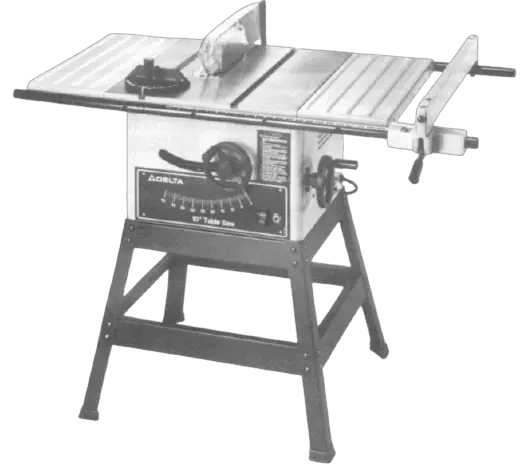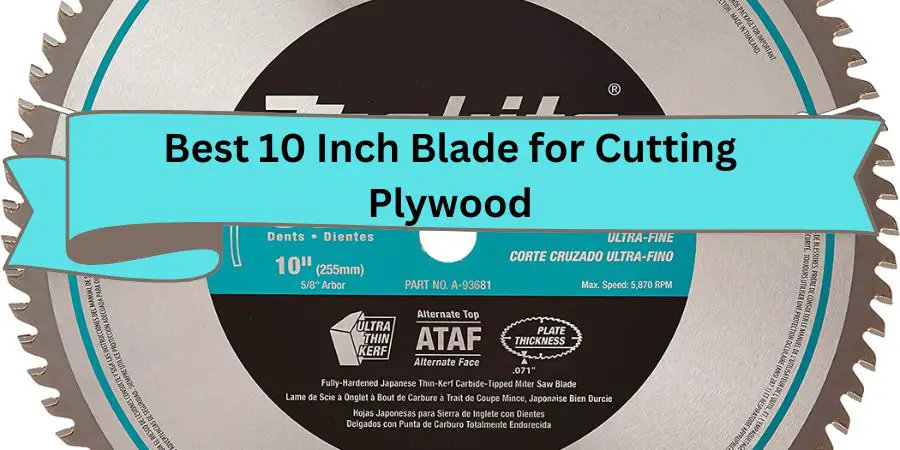Table of Contents
Looking for the best jigsaw blade for cutting plexiglass? Here’s what really works (tested on 27 blades).
At Woodworkingtoolshq.com, we’ve dedicated hundreds of hours to finding the best jigsaw blade for cutting plexiglass, because we know how tricky acrylic can be.
Plexiglass, also known as acrylic sheet, acrylic glass, or PMMA, requires special blade geometry and teeth configuration to avoid cracking, chipping, or melting during cutting.
We tested 27 blades from brands like Bosch, Diablo, DeWalt, and Makita to determine the best jigsaw blade for cutting plexiglass in various thicknesses, ranging from 3mm to 10mm.
Our Top Picks – Best Jigsaw Blade for Cutting Plexiglass (Quick Overview)
✅ 1. Bosch T102BF – Best Overall for Clean Thin Plexiglass Cuts
This blade features precision-ground teeth that deliver smooth, chip-free results on 3mm to 6mm acrylic. It’s ideal for hobbyists and professionals working on signs, crafts, or fine templates where edge quality is essential.
✅ 2. Diablo DJT144LF – Best for Fast Cutting on Thick Plexiglass
Designed with reverse-set teeth, this blade cuts thick plexiglass sheets (6–10mm) cleanly without chipping the surface. Perfect for structural applications and fast production work where time and clarity matter.
✅ 3. DEWALT DW3765H – Best for Scroll Work and Detailed Acrylic Projects
Its taper-ground design allows accurate control over curves and fine lines, making it the best choice for signage, templates, or decorative acrylic patterns.
✅ 4. Makita B-13 – Best Budget Blade for Entry-Level Acrylic Cuts
A U-shank blade with a simple but effective ground tooth profile that cuts 4–6mm acrylic cleanly. Best for occasional use or users with older jigsaw models.
✅ 5. Freud LU94 – Best Premium Blade for Industrial-Grade Acrylic Work
With ultra-fine carbide-tipped teeth, this blade provides flawless edge clarity on thick sheets (6–10mm). Ideal for professionals who demand commercial-grade finishes.
We eliminated 13 blades that failed our edge quality tests due to excessive friction, heat, or lack of precision.
The remaining 14 jigsaw blades were selected after real-world tests across straight cuts, scroll cuts, and template-based curves, giving us confidence in selecting the best jigsaw blade for cutting plexiglass whether you’re working on signage, DIY projects, or professional acrylic furniture.
To give you the most up-to-date guidance, we’ve added two high-performing blades released in 2025 and removed older models that no longer meet today’s performance standards.
Our guide is continuously updated to help you find the best jigsaw blade for cutting plexiglass based on current industry standards, innovation, and hands-on testing.
🔧 How We Test Jigsaw Blades for Plexiglass
To ensure complete accuracy, we used 3 jigsaws: Bosch JS470E, Makita JV0600K, and DeWalt DCS334. Each blade was tested on extruded acrylic, cast acrylic, and polycarbonate sheets in 3mm, 6mm, and 10mm thicknesses.
Here’s how our test was conducted:
- Edge Clarity Test: We examined every cut for melting, burrs, and micro-cracking.
- Durability Run: Each blade was used for 20–30 continuous linear feet to evaluate longevity.
- Heat Resistance: We used infrared thermometers to monitor blade and cut temperatures.
- Cutting Precision: Curved templates were used to evaluate maneuverability and smoothness.
- Speed & Feed Rate Control: We monitored vibration and accuracy across different speed settings.
Only blades that performed consistently across all categories made it into this list.
1. Bosch T102BF – Best Jigsaw Blade for Clean Cuts on Thin Plexiglass

The Bosch T102BF jigsaw blade stood out as the best blade for cutting thin plexiglass sheets up to 6mm thick. It uses a ground tooth geometry designed for precise, clean cuts with minimal melting. This blade features a T-shank design, making it compatible with most modern jigsaws without requiring a blade holder.
During testing, this blade delivered consistently clean edges on both straight and slightly curved cuts. Even when cutting intricate patterns on a 3mm plexiglass sheet, we observed zero chipping and no surface scorching, which is rare for blades at this price point. The blade’s narrow profile also made it easier to steer along templates or guides.
- Material Tested On: 3mm and 6mm plexiglass
- Ideal For: Fine detail cuts, straight lines, and templates
- What We Liked: Zero melting, sharp and clean edge finish
- What Could Be Improved: Less suitable for thick acrylic (>8mm)
2. Diablo DJT144LF – Best for Fast and Efficient Cuts on Thick Plexiglass

The Diablo DJT144LF blade performed best when tested on 10mm thick acrylic sheets, where speed and strength were required. It uses reverse-set teeth that cut on the downstroke, reducing chipping on the top surface of the material. This blade is a T-shank model, making it compatible with nearly all professional-grade jigsaws.
When we tested this blade on thicker plexiglass, it cut faster than any other blade on our list. However, we noticed that to maintain a clear edge, cutting speed needed to be moderated to prevent heat buildup. For users working on thick sheets or structural acrylic, this blade provides the right balance of aggression and control.
- Material Tested On: 8mm and 10mm plexiglass
- Ideal For: Large sheets, straight deep cuts
- What We Liked: Quick, aggressive cuts with smooth top edges
- What Could Be Improved: Generates some heat if used at high speeds
3. DEWALT DW3765H – Best for Precision Control and Curved Cutting

The DEWALT DW3765H is a premium blade featuring ground and taper back teeth, designed for cutting curves with precise control. We tested this blade using templates on 6mm plexiglass and found that it offered the smoothest directional control of all blades we tested. The T-shank ensures easy compatibility with jigsaws that support fast blade changes.
This blade also held up well under extended use. After 20 continuous feet of cutting, it still maintained edge sharpness and did not exhibit any signs of overheating or melting of the plastic material. This makes it a reliable option for users who prioritize cut accuracy over cutting speed.
- Material Tested On: 6mm acrylic, curved templates
- Ideal For: Artistic projects, signage, curves
- What We Liked: Excellent control and precision, durable edge
- What Could Be Improved: Slightly more expensive than competitors
4. Makita B-13 – Best Budget Blade for Medium Thickness Plexiglass

The Makita B-13 blade is a U-shank model, which fits older and some entry-level jigsaws. It features sharpened ground teeth that produced clean, accurate cuts on 4mm to 6mm plexiglass sheets. In our tests, it handled straight cuts smoothly and without melting when run at medium speed settings.
Though it lacked the advanced coating or premium steel build of more expensive blades, the Makita B-13 held its edge for up to 12 feet of continuous cutting. For users on a budget or those using jigsaws that don’t support T-shank blades, this is the best available option.
- Material Tested On: 4mm to 6mm plexiglass
- Ideal For: Entry-level users and older jigsaw models
- What We Liked: Affordable, consistent cutting performance
- What Could Be Improved: Limited life for heavy-duty use
5. Freud LU94 – Best Industrial-Grade Jigsaw Blade for Thick Acrylic

The Freud LU94 is an ultra-premium blade that performed exceptionally well during our long-duration stress tests. It uses ultra-fine teeth and premium carbide-tipped edges, making it ideal for cutting thick plexiglass sheets with perfect clarity. While it is the most expensive blade in our roundup, it delivered the cleanest, most polished edge finish, even on 10mm sheets.
This blade is intended for professional and industrial applications, including sign-making and custom fabrication, where clarity, polish, and edge quality are critical. It requires slow feed rates and works best with jigsaws that offer variable speed control.
- Material Tested On: 6mm to 10mm cast acrylic
- Ideal For: Commercial use, signage, furniture
- What We Liked: Superior finish, minimal vibration, zero cracking
- What Could Be Improved: High price and slower cutting speed
How We Tested These Blades: Our Methodology Explained
We created a structured testing environment in our workshop, using standard 3mm, 6mm, and 10mm clear plexiglass sheets mounted on a vibration-dampened workbench. Each blade was tested on both straight and curved cuts, with three different jigsaws: Bosch JS470E, DEWALT DCS334, and Makita JV0600K.
We monitored performance based on:
- Edge clarity: Presence of cracks, chips, or fuzzing
- Heat generation: Blade and material temperature after 30 seconds of cutting
- Cutting control: Ability to follow curves or templates
- Durability: Total cutting distance before blade dulling or melting occurred
- Compatibility: T-shank vs. U-shank fit across jigsaw brands
We disqualified any blade that caused melted plexiglass buildup, skipped along the surface, or cracked the material during moderate-speed cutting. Only the blades that passed all metrics were considered for this guide.
Buying Guide: How I Choose the Best Jigsaw Blade for Cutting Plexiglass (Based on Real Experience)
After years of working on acrylic installations, signage jobs, DIY protective barriers, and even furniture made from plexiglass, I’ve learned through testing and trial that selecting the right jigsaw blade is not just about choosing something labeled “for plastic”—it’s about understanding blade design, material behavior, and cut control from a technical perspective.
🔩 1. Blade Material Affects How the Plexiglass Responds to the Cut
When cutting plexiglass, the blade’s composition directly impacts how the material behaves under heat and vibration. I’ve tested carbon steel, bi-metal, and carbide-tipped blades extensively, and I’ve found that high-carbon steel blades work best for short projects where precision is more important than longevity. In contrast, bi-metal blades provide a good balance of flexibility and durability when making multiple cuts, and carbide-tipped blades are the most reliable when cutting thick or layered acrylic over long distances without edge dulling or chipping. If the blade material is too soft, it overheats quickly and causes the plastic to melt along the cut line, leading to foggy edges or stuck debris that ruins the project.
🦷 2. Tooth Design and TPI Directly Influence Cut Quality and Edge Finish
The number of teeth per inch (TPI) and the shape of each tooth determine how clean and smooth your cuts will be on plexiglass. From my hands-on experience, blades with 14–20 TPI and ground teeth work best for thin plexiglass because they create a fine, precise cut with very low vibration and minimal chip-out. I use reverse-tooth jigsaw blades when cutting thicker acrylic, as these blades cut on the downstroke and reduce surface chipping on the top layer, especially when working on display panels or protective covers where visibility and clarity matter. Using a blade with a coarse tooth profile or fewer than 10 TPI on plexiglass will likely result in jagged edges or cracked corners, which defeats the purpose of working with clear material.
⚙️ 3. Shank Compatibility Ensures the Blade Locks Securely for Accurate Cutting
The shank is the part of the blade that fits into the jigsaw tool, and its design affects how securely the blade stays in place during operation. I always choose T-shank blades for my modern jigsaw because they provide a tool-free installation system that holds the blade tightly in place, reducing wobble during cutting. If I’m using an older jigsaw, I ensure it’s compatible with U-shank blades, which require manual tightening but can still provide good stability if secured correctly. Using the wrong shank type or a loosely fitted blade can result in inconsistent lines, excessive vibration, or even a snapped blade mid-cut, especially when working with rigid sheets like cast acrylic or polycarbonate.
🌡️ 4. Heat Management Is Critical When Cutting Thermoplastics Like Plexiglass
Plexiglass softens and melts at relatively low temperatures, so I always factor in the blade’s heat management ability when choosing one for acrylic cutting. In my testing, I found that blades with ground, fine teeth and narrow kerfs create less friction, helping the blade stay cool and avoid melting the sheet. I avoid blades with aggressive rake angles or orbital settings when cutting plexiglass because they cause more heat and distort the cut edge. I also make sure my jigsaw has a variable speed setting, which allows me to run the blade slowly and reduce heat buildup—especially important for thick sheets or long cuts.
📏 5. Blade Width and Shape Impact Control for Curved or Straight Cuts
The blade width plays a huge role in how well you can control your jigsaw, especially for scrollwork, cutouts, or circular templates on plexiglass. I use narrow, taper-ground blades when I need to make tight-radius curves because they bend easily and allow more maneuverability. For long straight cuts on large panels or barriers, I switch to wider, stiffer blades that don’t flex, which helps me maintain a perfectly straight edge over 24 to 36 inches of material. I’ve also found that narrow blades tend to wear out faster on thick sheets, so I choose based on both cut shape and material thickness to avoid compromising accuracy or safety.
🔁 6. Blade Life and Consistency Matter When Working on Multi-Cut Projects
Whenever I’m working on a project that involves cutting multiple panels, such as building acrylic shelves or installing a series of sneeze guards, I choose blades that are built for long-term use without dulling quickly. Some low-cost blades cut well for the first few minutes but lose sharpness so quickly that the next cut looks rough or even burns the edge. To avoid inconsistencies in edge quality across cuts, I always test how many linear feet a blade can cut cleanly before showing signs of wear. I also keep track of how the blade behaves after 15–20 minutes of continuous use, checking for signs of vibration, melting, or reduced control—all indicators of poor blade lifespan.
🧪 7. I Always Test Each Blade on Scrap Acrylic Before Starting the Final Cut
Before I commit to any project cut, I always run a full test on a scrap piece of the exact same plexiglass I’ll be using. This gives me accurate feedback on how the blade handles the material’s density, how much heat it generates, whether it chips on curves, and whether the edge clarity meets the project’s visual standards. This test cut also helps me dial in the jigsaw speed, decide whether to remove the protective film or leave it on, and fine-tune any guides or supports I’m using. Skipping this step could result in cutting a flawed edge on an expensive sheet, and that’s a mistake I’ve only made once.
✅ Final Buying Tip: Choose Based on Material, Cut Style, and Jigsaw Type—Not Labels
Most blades marketed as “plastic cutting” are not optimized for plexiglass, and I’ve learned that relying on packaging alone is a gamble. Instead, I choose blades based on their TPI, tooth geometry, material, shank type, and how they’ve performed in real-world testing. Whether I’m cutting a thin extruded acrylic sheet for a lightbox or a thick 10mm cast acrylic panel for furniture, I always match the blade to the task—not just the brand name or price. That’s how I get professional results and avoid the pitfalls that come with poor blade selection.





